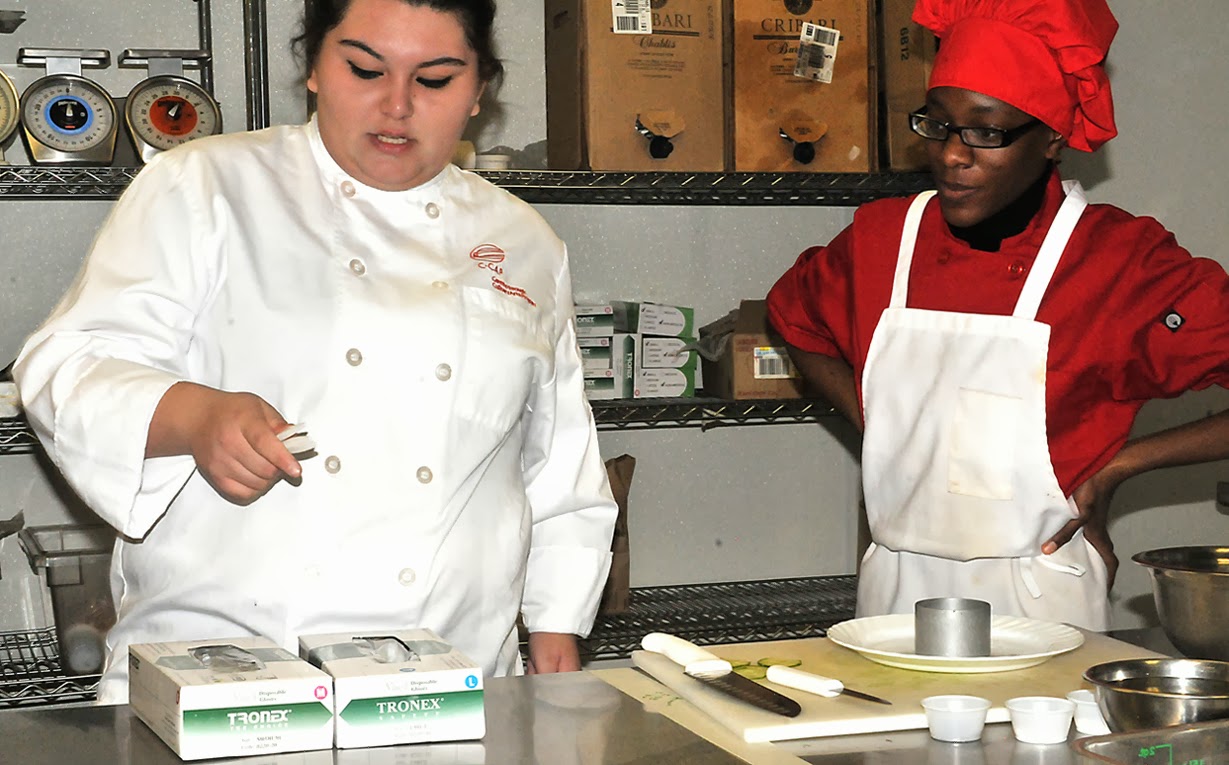14sept19

Friday, January 31, 2014
Tips, tricks and assists
Okay, students! We've seen you practicing (do it some more!), and you've
heard the suggestions.
But what you really want to know is - how the heck
can I ace this C-CAP competition?
Stick around, we'll help. First, get yourself a coupla lists. You need a list for your timing, you
need a list for your equipment and set up.
Here's what we have for you: A complete equipment list, in order,
with tips on how to get yourself set up.
Best part? This is direct
from C-CAP, and you can find it here:
http://www.ccapinc.org/locations/wp-content/uploads/2009/08/Preliminary-Competition-Details1.pdf (this is a live link!)
Next: Here's the list of tips for preparing that
salad and the omelet:
Suggested Order of Preparing
Competition Salad
1 . Core, score, blanch and shock tomato – leave in ice bath only
until cool, put back on mise en place tray
2. Make vinaigrette, taste, adjust seasonings and put on ice bath
3. Peel and cut jicama (small dice – ¼ inch by ¼ inch) – add to
vinaigrette
4. Cut bell peppers into small dice – add to vinaigrette
5. Cut onion into small dice – add to vinaigrette
6. Peel, seed and cut tomato into small dice – add to vinaigrette
7. Cut cucumber slices for ring mold
8. Plate cucumber slices in ring mold
9. Peel, seed, and cut remaining cucumber into small dice – add to
vinaigrette
10. Taste and adjust seasonings
11. Strain all vinaigrette from diced vegetables
12. Put strained vegetables into ring mold
13. Clean plate
Suggestions
1. Have only one tool and one food product on cutting board at one
time
2. Wipe cutting board and knife with clean side towel (not
sanitizer) between each vegetable preparation– sanitize only when needed
3. Fill ring mold with diced vegetables to the top of the cucumbers
– do not overfill or underfill
4. Cut only the amount of vegetable as needed – this shows good
time management and good product management (use all bell pepper and tomato
given- other vegetables can be cut as needed)
5. Put all usable food product back on mise en plus tray – not in
trash container
6. Use chef knife to make all small dices and to cut cucumber
slices
7. Line cucumber slices on the top of the cutting board as sliced
off of the cucumber– this method keeps the slices in order, makes plating
easier, and saves time
8. Practice to the 35 minute mark, time deductions will be taken
for every minute salad is late
9. Wear gloves while making and plating salad, no bare hands on
ready-to-eat food
10. Wet paper towels or rubberized mats only under cutting board (no
side towels under cutting board)
A few more tips on omelets
Remember - break your eggs on the edge of your cutting board,
not your bowl (you don't want any stray bacteria in your omelet).
Agitate your eggs, using a whisk or a fork, making certain to
beat them enough to remove any indication of egg white (you need to break the
whites so no strings of white show through in your omelet).
[Special note: C-CAP standards are especially rigorous
here. You need to NOT have any clumps, bumps or strings of white showing
in your omelet.]
Have your pan hot. Really hot.
Don't let your eggs sit still in the pan; you need to keep the
eggs and pan moving.
Fortunately, this won't take long (it's a really hot pan,
remember?)
Moving the pan and eggs constantly keeps the curds of egg small,
and in this case, small means tender. You want to have a consistent, very
tender feel to your omelet, inside and out.
Shift the eggs to one side of the pan, tilt the pan and use your
fork to help roll the omelet out of the pan onto a plate (this should help you
have a near-perfect roll to your omelet). The eggs will still be slightly
wet. (Don't forget how Jill and the other practice chefs have shown you
how to hold that skillet!)
And why do you not want it brown? (NO! Not a teeny
bit!) If your omelet is browning, there are a couple of reasons.
· You're not stirring it
enough while it's cooking. Omelets cook quickly and you must not stop
moving those eggs around.
· You overcooked it. This
omelet does not look entirely dry when it's done; it should have a little
glistening sheen to it.
· You didn't whip the eggs
sufficiently to start with: browning indicates there's albumin - that's
egg white! - that wasn't entirely incorporated in your mixing.
· [Note, again: C-CAP
standards ask that this omelet be a nice, golden yellow. Definitely NOT
browned. Tip - don't brown the omelet. This takes practice!]
This omelet only salt and pepper in it - and it needs enough to
be apparent in the taste. So season judiciously!
Finally, make sure your plate is completely clean before
presenting your omelet for judging.
Make sure there are no butter or oil slicks on the plate, and definitely
no stray pieces of egg.
Thursday, January 30, 2014
Subscribe to:
Posts (Atom)

















































